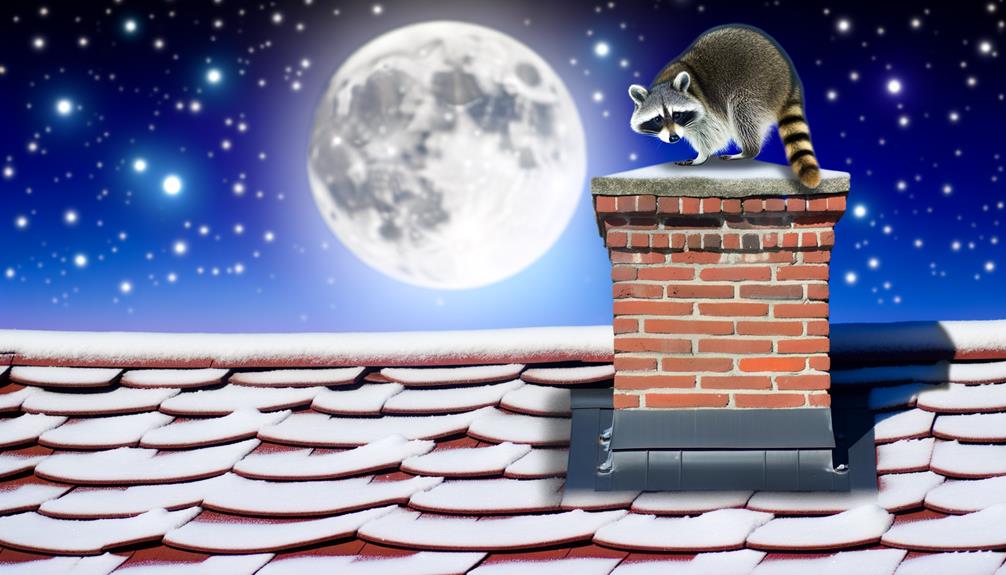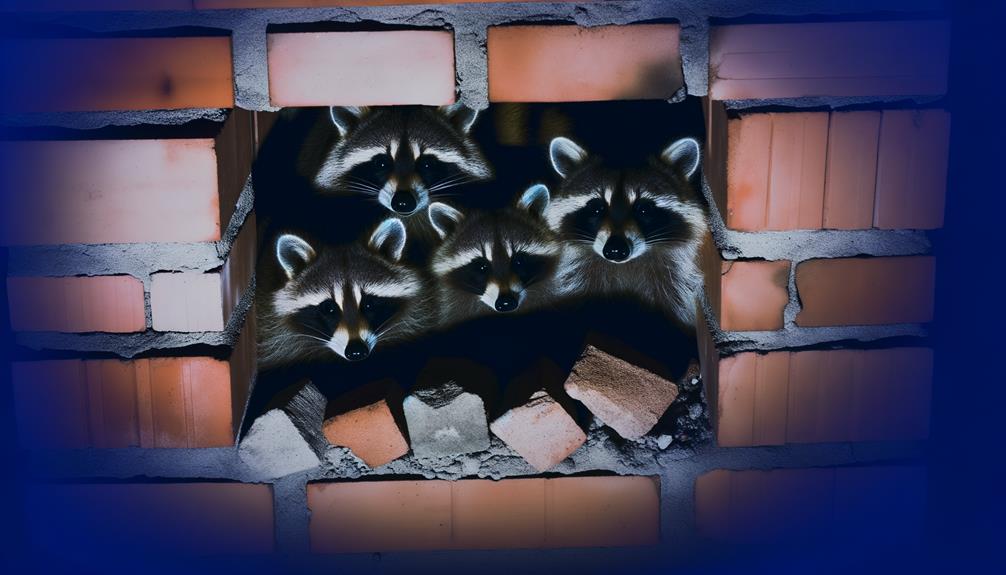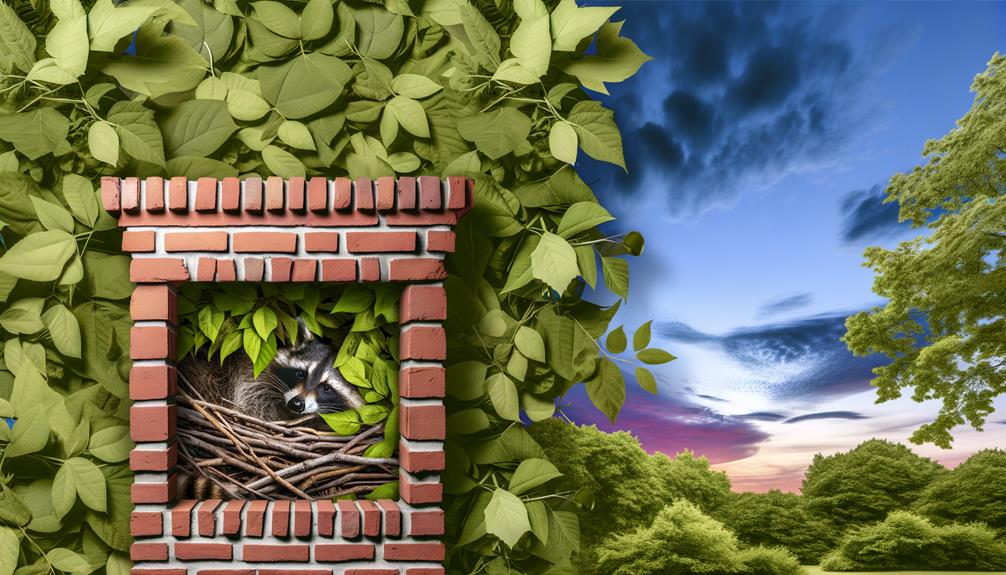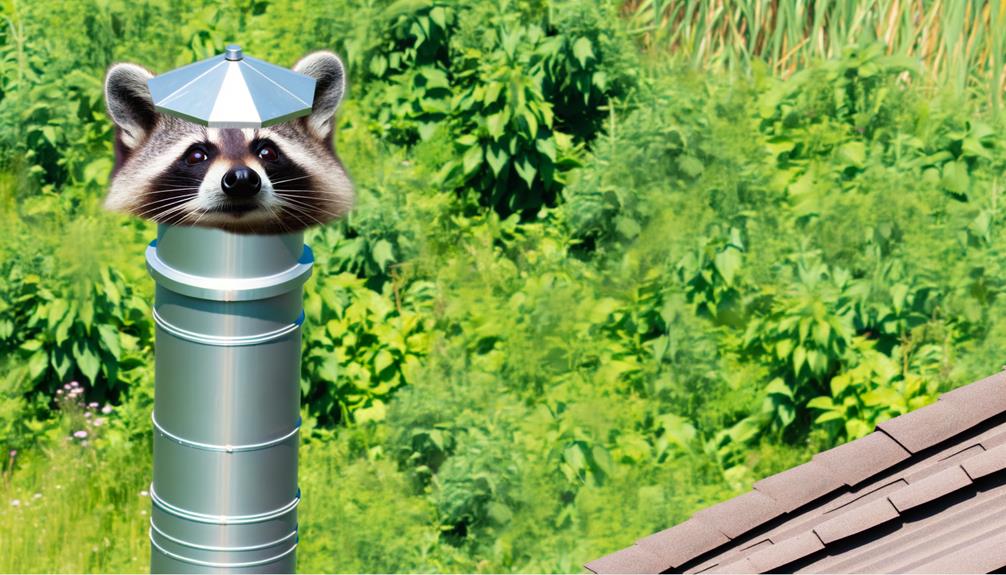Do Raccoons Live in Chimneys?
Raccoons often inhabit chimneys due to their structural similarity to hollow trees, offering insulation and temperature stability. These locations provide safety from terrestrial predators and minimal human disturbance.
Indicators of a raccoon infestation include nocturnal sounds such as scratching and chattering, as well as debris, nesting materials, and droppings. The risks of raccoons in chimneys encompass potential damage to chimney linings, fire hazards from obstructed airflow, and various health risks from pathogens.
Effective identification and prevention are essential for maintaining a safe and healthy environment. To learn about prevention and cleanup methods, consider the following guidelines.

Key Takeaways
- Raccoons choose chimneys for nesting as they mimic hollow trees.
- Chimneys provide raccoons with insulation, stable temperature, and protection from predators.
- Nocturnal sounds like scratching and chattering indicate raccoons in chimneys.
- Raccoons pose risks such as fire hazards and health issues when nesting in chimneys.
- Prevention includes trimming nearby branches and sealing vents to deter raccoon entry.
Why Raccoons Choose Chimneys

Raccoons often choose chimneys as their nesting sites due to the structures' warmth, protection from predators, and relative seclusion. The vertical nature of chimneys mimics the hollow trees raccoons naturally prefer, providing a safe and elevated environment.
The brick or metal construction of chimneys offers insulation, maintaining a stable temperature ideal for raising young. Additionally, chimneys present fewer threats from terrestrial predators, enhancing the survival prospects of raccoon kits.
The secluded aspect of chimneys minimizes human disturbance, making them an attractive option for these nocturnal mammals. This combination of safety, warmth, and privacy effectively meets the raccoon's nesting requirements, explaining their frequent habitation of such urban structures.
Signs of Raccoons in Chimneys
Identifying the presence of raccoons in chimneys can be accomplished by noting specific indicators. Homeowners may observe nocturnal activity sounds such as scratching or chattering emanating from the chimney.
Additionally, the presence of debris, including nesting materials and droppings, can serve as further evidence of raccoon habitation.
Nocturnal Activity Sounds
During the nighttime hours, distinctive rustling, scratching, and chittering sounds emanating from within chimneys often indicate the presence of raccoons. These nocturnal creatures are primarily active after dusk, engaging in various behaviors such as grooming, nesting, and communicating with each other.
The rustling noises can be attributed to their movements and foraging activities, while scratching sounds are often a result of their attempts to climb or navigate the chimney structure. Chittering and other vocalizations are typical of raccoons, especially when mothers communicate with their young.
These auditory signs are essential for homeowners to recognize, as they may signal a raccoon infestation that requires prompt attention to prevent potential structural damage or health risks associated with these animals.
Chimney Debris Evidence
In addition to nocturnal activity sounds, physical evidence in the form of debris within the chimney can also indicate the presence of raccoons. Observationally, raccoons often bring nesting materials such as twigs, leaves, and other vegetation into chimneys.
Moreover, raccoon feces, commonly termed scat, may be found within or around the chimney's base. These droppings are typically dark, cylindrical, and about the size of small dog feces. Claw marks or scratches on the chimney walls can also serve as indicative signs of raccoon activity.
Additionally, the presence of fur caught in crevices or around the chimney opening further supports their habitation. Such evidentiary debris provides valuable insights for confirming raccoon residency within chimney structures.
Raccoon Nesting Habits

Raccoon nesting habits exhibit a preference for enclosed spaces that provide safety and seclusion, making chimneys an attractive option for establishing dens. These nocturnal mammals seek out locations that offer protection from predators and harsh weather conditions.
Female raccoons, in particular, display a heightened inclination to utilize such areas during the birthing and rearing of their young. This preference for enclosed, elevated areas ensures that the young remain undisturbed and secure.
Raccoons are opportunistic and adaptable, often exploiting human-made structures like attics, crawl spaces, and chimneys. Their nests, typically comprising twigs, leaves, and other available materials, are constructed to offer maximum comfort and insulation.
Observations indicate that raccoons will repeatedly return to favorable nesting sites across different seasons.
Risks of Raccoons in Chimneys
While raccoons' preference for chimneys as nesting sites ensures their safety and seclusion, it also introduces several risks to homeowners and the structural integrity of their properties. Raccoons can cause significant damage to chimney linings, leading to costly repairs.
Their nesting materials and feces can obstruct airflow, posing a fire hazard and increasing the risk of carbon monoxide buildup. Moreover, raccoons are known carriers of various pathogens, including rabies and raccoon roundworm, which can pose health risks to humans.
Additionally, their presence may attract other pests, exacerbating the problem. Addressing these risks promptly is essential to maintaining a safe and healthy living environment.
Identifying Raccoon Entry Points

Identifying raccoon entry points is critical for effective management and prevention. Common signs include displaced chimney caps, scratch marks, and droppings near the chimney base.
Additionally, raccoon trails can be detected by observing disrupted vegetation or mud tracks leading to the chimney area.
Common Entry Signs
Homeowners often first detect raccoon presence through observable signs such as disturbed insulation or visible droppings near the chimney. Other common indicators include unusual noises, particularly scratching and chattering sounds emanating from the chimney or attic areas.
In addition, raccoons may leave behind greasy smudges or claw marks around entry points, as their fur and claws can transfer oils and dirt. Damaged or displaced chimney caps and shingles can also signal an entry point. Raccoons tend to displace debris, such as leaves and twigs, which they drag into the chimney to construct nests. These signs collectively help in identifying potential raccoon intrusion, allowing homeowners to take appropriate measures for wildlife management and property protection.
Detecting Raccoon Trails
In addition to recognizing common signs of raccoon presence, it is important to meticulously examine potential entry points to accurately detect raccoon trails into the chimney. Look for structural vulnerabilities such as loose shingles, damaged soffits, or gaps around the chimney cap.
Pay attention to scratch marks or oily smudges on surfaces, indicating repeated use by raccoons. Also, inspect for claw marks on the chimney's exterior, which can be a clear indicator of raccoon activity. Droppings, nesting materials, or tufts of fur near these entry points further corroborate their presence.
Using a flashlight, probe the chimney interior for signs of nesting or recent activity, ensuring a thorough assessment of potential raccoon trails.
Humane Eviction Methods
Effective humane eviction methods for raccoons living in chimneys involve using non-lethal techniques that encourage the animals to leave voluntarily without causing them harm. Utilizing auditory and visual deterrents, such as bright lights or loud noises, can create an inhospitable environment for raccoons, prompting them to vacate.
Additionally, placing ammonia-soaked rags or commercial raccoon repellents near the chimney can further discourage their presence. It is critical to make sure that no young raccoons are left behind, as maternal separation can cause distress.
After confirming the raccoons have exited, a professional wildlife removal service should inspect the area to confirm complete eviction. These methods prioritize animal welfare while effectively resolving the issue of raccoons residing in chimneys.
Preventing Raccoon Intrusions

To effectively prevent raccoon intrusions, it is essential to secure all potential entry points around the chimney and roof areas with sturdy materials such as steel mesh or chimney caps. These materials should be resistant to gnawing and weather, ensuring long-lasting effectiveness.
Regular inspections are critical to identify and repair any damage or wear, which raccoons can exploit. Additionally, trimming tree branches that provide easy access to the roof can significantly decrease the likelihood of raccoon entry.
Ensuring that all vents and openings are properly sealed with raccoon-proof covers further minimizes intrusion risks. Employing these preventive measures not only safeguards the structural integrity of the chimney but also maintains the safety and hygiene of the home environment.
Cleaning Up After Raccoons
Effective cleaning after raccoon intrusions involves the safe removal of debris and meticulous attention to odor and stain elimination. Ensuring all nesting materials and contaminants are properly disposed of is essential for maintaining a hygienic environment.
Additionally, specialized cleaning agents may be required to address persistent odors and stains left by raccoon activity.
Removing Debris Safely
Properly removing debris left by raccoons in chimneys requires a systematic approach to guarantee the safety of both the individual performing the cleanup and the integrity of the chimney structure. Begin by wearing protective gear to avoid contact with potential pathogens. Utilize a chimney brush to dislodge loose materials, being cautious of fragile areas. A thorough inspection is essential to identify any structural damage.
| Step | Tools Required | Safety Precautions |
|---|---|---|
| Wear gear | Gloves, mask, goggles | Prevent pathogen contact |
| Dislodge debris | Chimney brush | Avoid fragile sections |
| Inspect | Flashlight, mirror | Identify damage |
| Clean | Vacuum, broom | Proper disposal methods |
| Final check | Inspection camera | Ensure completeness |
Effective cleanup minimizes health risks and preserves chimney functionality.
Odor and Stain Removal
After verifying the chimney is free from debris, addressing the odors and stains left behind by raccoons is the next critical step in the cleanup process.
Raccoon urine and feces can permeate masonry, producing persistent odors and unsightly stains. Utilize enzymatic cleaners specifically designed to break down organic residues. These cleaners effectively neutralize odor-causing molecules and lift stains from porous surfaces.
For deeper stains, a mixture of water and baking soda can be applied, followed by thorough scrubbing with a stiff-bristled brush. Ensure proper ventilation during and after cleaning to expedite the drying process and prevent mold growth.
Professional Wildlife Removal

Engaging expert wildlife removal services is crucial to ensure the safe and compassionate extraction of raccoons from chimneys. Professionals utilize specialized techniques and equipment to evaluate the situation accurately and develop an effective removal strategy.
They often use non-lethal methods such as exclusion devices that allow raccoons to exit but not re-enter, thereby preventing harm to the animals. Additionally, wildlife removal experts adhere to legal and ethical guidelines, minimizing stress and injury to raccoons.
Their expertise extends to identifying entry points and evaluating potential damage, ensuring thorough solutions. Moreover, professionals often provide immediate remediation of any contamination or structural damage caused by raccoon activity, thereby safeguarding both human health and property integrity.
Long-Term Prevention Strategies
Implementing long-term prevention strategies is vital for ensuring that raccoons do not reoccupy chimneys, thereby maintaining the safety and integrity of residential properties. Key measures include installing chimney caps and securing attic vents, which serve as primary barriers against wildlife intrusion. Regular inspections and maintenance are also essential for identifying and remedying potential entry points.
| Prevention Method | Description |
|---|---|
| Chimney Caps | Metal or mesh caps that block raccoon access |
| Securing Attic Vents | Reinforcing vents with durable materials to prevent entry |
| Regular Inspections | Routine checks to identify and fix potential entry points |
Conclusion
To sum up, raccoons often select chimneys for nesting because of the shelter and warmth they offer, presenting substantial risks like structural damage and health hazards.
Surprisingly, research shows that as many as 30% of urban residences could face raccoon intrusions.
Recognizing entry points and putting preventive measures in place are key to reducing these problems.
Expert wildlife removal and comprehensive cleanup are necessary for upholding home safety and avoiding future infestations, highlighting the significance of proactive wildlife management strategies.






